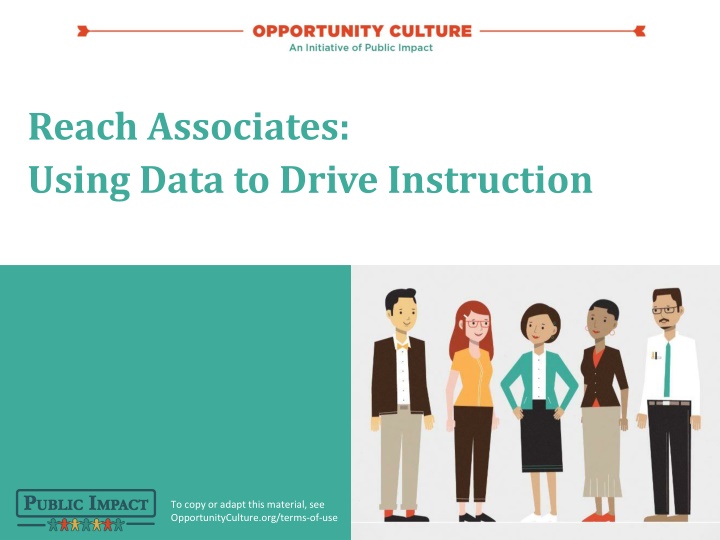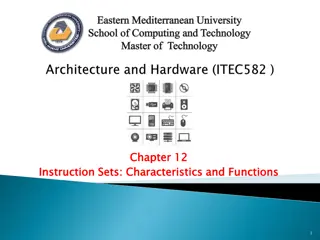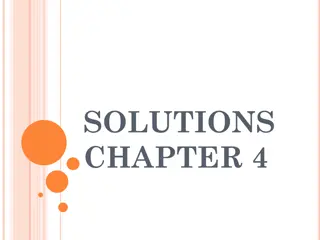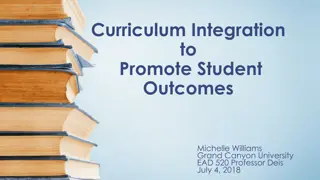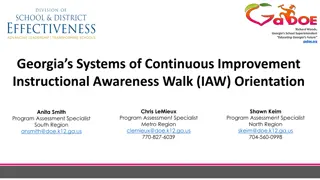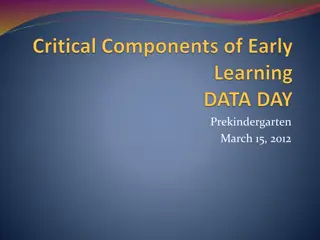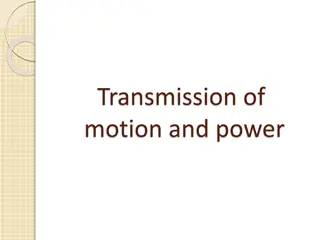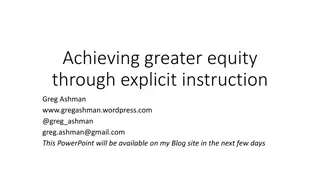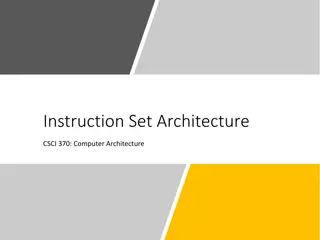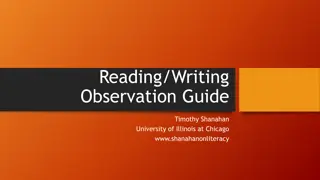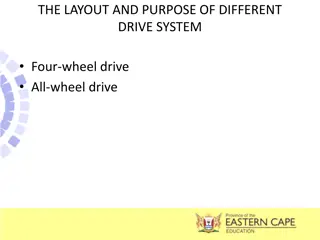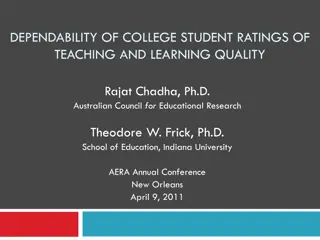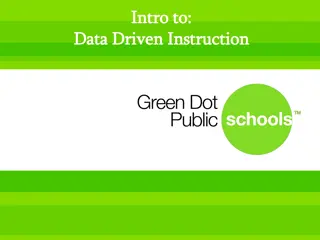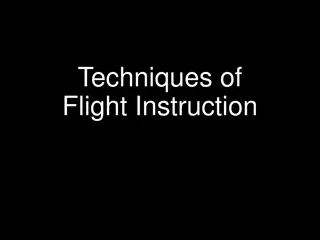Using Data to Drive Instruction: Enhancing Student Learning
Explore the significance of data-driven instruction in education, focusing on the types of student learning data collected and utilized for instructional improvements. Discover the role of formative assessments in identifying learning needs and adjusting teaching strategies accordingly. Dive into practical phases for utilizing data to enhance student learning outcomes effectively.
Download Presentation

Please find below an Image/Link to download the presentation.
The content on the website is provided AS IS for your information and personal use only. It may not be sold, licensed, or shared on other websites without obtaining consent from the author.If you encounter any issues during the download, it is possible that the publisher has removed the file from their server.
You are allowed to download the files provided on this website for personal or commercial use, subject to the condition that they are used lawfully. All files are the property of their respective owners.
The content on the website is provided AS IS for your information and personal use only. It may not be sold, licensed, or shared on other websites without obtaining consent from the author.
E N D
Presentation Transcript
Reach Associates: Using Data to Drive Instruction To copy or adapt this material, see OpportunityCulture.org/terms-of-use 2019 |1
Do Now See Handout Use the KWL chart in your handouts to reflect on what you already know and questions you have about using data to drive instruction: Know (K) Want to Know (W) Learned (L) Teachers collect lots of data (exit tickets, weekly quizzes, unit tests, state tests) What can I do with all the data I collect? 2019 |2
Session Objectives Identify the general types of data that can inform instructional improvements. Learn ways RAs can assist their MCL or TRT in collecting and reporting data to drive instruction. 2019 |3
Types of Student Learning Data What types of student learning data do we collect and use? When? Type When Examples Diagnostic At the start of a new learning cycle Beginning of year or semester test; pre-unit test, self-assessment Formative Frequently From checking for understanding or observing several times a class to daily exit tickets to weekly quizzes or tests; benchmark exams Summative At the end of a learning cycle End-of-semester test, finals, state assessment 2019 |4
Turn and Talk Why do formative assessments matter? "The frequent, interactive checking of student progress and understanding in order to identify learning needs and adjust teaching appropriately." Younglove, (In)Formative Assessment: The Key to Accountability, 2011 2019 |5
Check for Understanding Which of these are formative assessments? Source: http://tea.texas.gov/uploadedImages/Student_Assessment /STAAR-logo.png Source: https://s-media-cache- ak0.pinimg.com/236x/8d/df/36/8dd f3621a3736c629749718cba850a48.j pg Source: http://www.superteachertools.us/jeopardyx/images/screenshot.jpg BONUS: Is a check for understanding itself a form of formative assessment? Thumbs up if you agree; Thumbs down if you disagree 2019 |6
Using Data to Drive Improvement See Handout Phase 1:Collect and prepare a variety of data about student learning Phase 3: Modify instruction to test hypotheses and interventions to increase student learning Phase 2: Interpret data and develop hypotheses about how to improve student learning Source: IES Practice Guide: Using Student Achievement Data to Support Instructional Decision Making, 2009 2019 |7
Phase 1 Phase 1:Collect and prepare a variety of data about student learning Phase 3: Modify instruction to test hypotheses and interventions to increase student learning Phase 2: Interpret data and develop hypotheses about how to improve student learning Source: IES Practice Guide: Using Student Achievement Data to Support Instructional Decision Making, 2009 2019 |8
Collect and Prepare a Variety of Data Formative Assessment Example Individual Subgroups Whole Group Do Now Exit Ticket Quiz Poll Everywhere Fist to Five Cold Call Thumbs Up/Down Observation 2019 |9
Think-Pair-Share 1. Have you used any of these checks for understanding before? If so, which type have you used in the past? If not, which would you like to use? 2. How and why did you use these or would you like to use these? 3. What would gathering this information allow you to do? Time for this activity: 2 minutes 2019 |10
Be Thoughtful About How and When To Collect Data Consider: Variety Frequency Usefulness Best: Plan your formative assessments in advance of your lessons and units Best: Use multiple methods to gauge individual, subgroup, and whole-class progress Best: Collect only data that will help you reflect on how you can better help all learners master the objectives Adapted from KIPP.org blog 2019 |11
Use Tools to Record Data for Effective Analysis Tools to maintain data records, including from checks for understanding Data tracker (such as Excel or Google Docs) Online gradebook (such as Engrade.com) Computer-based system Student-based system (tracking their own progress) What other resources/examples can you share? Source: https://s-media-cache-ak0.pinimg.com/736x/18/f5/ac/18f5acdf212b520a4b3b8c299ba21a5d.jpg 2019 |12
Think-Pair-Share 1. How can you use your role as a reach associate to collect and prepare data (to improve student learning for your team of teachers)? 2. What expectations have been set for your role in collecting and preparing data? How can you confirm these expectations with your MCL, TRT, or administrator? 3. What routines for collecting and preparing data could be most helpful to supporting your students? Time for this activity: 2 minutes 2019 |13
Phase 2 Phase 1:Collect and prepare a variety of data about student learning Phase 3: Modify instruction to test hypotheses and interventions to increase student learning Phase 2: Interpret data and develop hypotheses about how to improve student learning Source: IES Practice Guide: Using Student Achievement Data to Support Instructional Decision Making, 2009 2019 |14
Be Disciplined About Your Data Analysis Analyze data to adjust courseduring the lesson and to inform needsfor future lessons Combine multiple data sources to hone in on the biggest gaps and opportunities for student learning Be sure to think about why students are/aren t learning(teacher actions vs. student actions), and what you can do to help all students learn 2019 |15
How RAs Can Identify Trends During Class Scan do now responses After Class Scan exit tickets Note which students will need more help based on observation Review daily/weekly quizzes to understand which standards require reteaching Direct cold calling toward representatives of student subgroups to understand distinct needs Reflect on which teacher actions had the greatest/least success for all students What other ways can you analyze data during and after class? 2019 |16
Work With Your Teaching Partner Do you know the flow and key points of the lesson ahead of time? This will help you tune into the right checks for understanding to use. Can you anticipate which parts of the lesson or which particular topics will be the most challenging for your students to master? What routines exist to collect and analyze data for your grade? What will your role be? How will you and your MCL/TRT communicate about data findings? 2019 |17
Phase 3 Phase 1:Collect and prepare a variety of data about student learning Phase 3: Modify instruction to test hypotheses and interventions to increase student learning Phase 2: Interpret data and develop hypotheses about how to improve student learning Source: IES Practice Guide: Using Student Achievement Data to Support Instructional Decision Making, 2009 2019 |18
Whats Next? Once you ve identified what additional support students need based on your formative assessment strategies, you have options: Allocate more time for topics where students are struggling Scaffold lessons by providing tools for each chunk of learning Designate particular students to receive additional help with particular skills using grouping or regrouping Reteach difficult or complex concepts Use data to inform whom you target for cold-calling 2019 |19
Practice: Collect Data Scenario You are teaching 3rd-grade math today For today s lesson, the main objective is: Students will be able to count coins and bills up to $5.00 Come up with: A check for understanding question that you could use while working one-on-one with a student to determine if they are on track toward mastering the objective A check for understanding question you could use while working with a small group of students to assess mastery 2019 |20
Practice: Interpret Data See Handout Scenario You are asked to analyze the exit ticket responses at the end of class. Form pairs to review the exit ticket tracker and complete the analysis. Be prepared to share your responses to the four analysis questions. 2019 |21
Practice: Modify Instruction Scenario After reviewing the exit ticket data and reflecting on your lesson, you see some students are confused they counted the number of bills/coins vs. adding up the value. You also realize that all students who offered an incorrect response were seated in the back. What steps will you take to ensure those students master the objective? What might you do in the future if teaching this objective again? 2019 |22
Closing: Using Data to Drive Improvement Phase 1:Collect and prepare a variety of data about student learning Phase 3: Modify instruction to test hypotheses and interventions to increase student learning Phase 2: Interpret data and develop hypotheses about how to improve student learning Think-Pair-Share: How might this cycle work if executed on a daily basis? Weekly? Can it work within a single lesson? Source: IES Practice Guide: Using Student Achievement Data to Support Instructional Decision Making, 2009 2019 |23
Exit Slip See Handout 1. Update your KWL chart. 2. Write down the three most important things you learned onto a sticky note along with your name. 3. Add it to our exit ticket chart paper. Know (K) Want to Know (W) Learned (L) Teachers collect lots of data (exit tickets, weekly quizzes, unit tests, state tests) What can I do with all the data I collect? 2019 |24
Action Steps Write down and share out a few next steps you commit to incorporating into your work based on your takeaways from this session. Next Steps By Whom By When Notes/Resources Meet with TRT or MCL to learn what types of assessments students will have. TRT or MCL ASAP Meet with TRT or MCL to discuss my role with assessment and how I can support them to interpret data and adjust instruction. TRT or MCL ASAP Script out directions for procedures and expectations when students are working on assessments so they have a learning environment conducive to doing their best work. TRT or MCL Before first assessment Refer back to Successful Classroom Management session. 2019 |25
Follow Us! Keep up to date on Opportunity Culture with resources and research from Public Impact by following: @OppCulture @PublicImpact Facebook.com/OpportunityCulture Facebook.com/PublicImpact LinkedIn.com/company/public-impact---chapel-hill-nc Subscribe to the quarterly Opportunity Culture newsletters, with content by and for Opportunity Culture educators, and sign up to get Remind messages for them: Remind.com/join/ocnew OpportunityCulture.org/mailing-list/ 2019 |26
